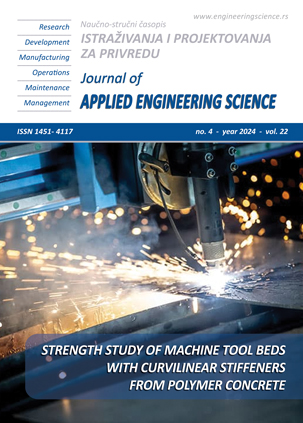NUMERICAL MODELING OF EMBANKMENT ON THIN CLAY SOIL WITH GEOFOAM
Abstract
Soft soils cause problems in road subgrades because they have low bearing capacity. Embankments on soft ground need to be identified and reviewed before construction starts. Various soil reinforcement techniques can be used to improve soft soil conditions. This research focuses on using geofoam material as an embankment on soft soil. The aim is to analyze the modeling of soft soil embankment with geofoam. The research method is a numerical method using the Plaxis 2D version 2023 application. There are two models in this study, namely the embankment model without geofoam, 100 cm thick subgrade, and the embankment model with 30 cm thick and 40 cm thick geofoam. The embankment geometry model is assumed to be symmetrical, hardening soil parameters are used to model soft soil for analyzing consolidation settlement, and elastic linear parameters to model geofoam. The type of FEM analysis in this research is plain strain. Numerical results at a maximum load of 100 kN showed a settlement of 0.1587 mm at 30 cm geofoam thickness and 0.1507 mm at 40 cm geofoam thickness. Deformation of 16 mm in 30 cm thick geofoam and 15.22 mm in 40 cm thick geofoam. Soil stress of 201 kN/m² in 30 cm thick geofoam and 192 kN/m² in 40 cm thick geofoamm. In conclusion, the model of embankment on soft soil with geofoam is that the thicker the geofoam used, the smaller the settlement and the stress on the soil that occurs.
References
Gultom, J., Pratikso, & Rochim, A. (2022). Floating road construction on soft soil. ICCDA 4, 955(1).
Widodo, B., Pratikso, & Rohim, A. (2022). A bearing capacity of bamboo cluster on saturated soft soil based on the direct load test and CPT’s data. IJSCET, 13(4), 390–398.
Mahasneh, B. Z., Maaitah, O. N., Hadi, N. A., Mubeideen, H., Alghazawi, O. K., & Saada, N. M. (2023). Utilizing natural additives in stabilizing clayey soil. Journal of Applied Engineering Science, 21(3), 749–757. https://doi.org/10.5937/jaes0-39089
Puppala, A. J., Manosuthikij, T., & Chittoori, B. C. S. (2013). Swell and shrinkage characterizations of unsaturated expansive clays from Texas. Engineering Geology, 164, 187–194. https://doi.org/10.1016/j.enggeo.2013.07.001
Zianal, N. F. A., Yusof, M. F., Madun, A., Pakir, F., Talib, M. K. A., & Talib, Z. A. (2021). Numerical modelling of soft soil improvement using expanded polystyrene geofoam for road embankment. Journal of Sustainable Underground Exploration, 2(1), 46–54.
Al-Taie, E., Al-Ansari, N., & Knutsson, S. (2015). Estimation of settlement under shallow foundation for different regions in Iraq using SAFE software. Engineering, 7(7), 379–386. https://doi.org/10.4236/eng.2015.77034
Puppala, A. J., Ruttanaporamakul, P., & Congress, S. S. C. (2019). Design and construction of lightweight EPS geofoam embedded geomaterial embankment system for control of settlements. Geotextiles and Geomembranes, 47(3), 295–305. https://doi.org/10.1016/j.geotexmem.2019.01.015
Siabil, S. M. A. G., Tafreshi, S. N. M., Dawson, A. R., & Omran, M. P. (2019). Behavior of expanded polystyrene (EPS) blocks under cyclic pavement foundation loading. Geosynthetics International, 26(1), 1–25. https://doi.org/10.1680/jgein.18.00033
Giuliani, F., Autelitano, F., Garilli, E., & Montepara, A. (2020). Expanded polystyrene (EPS) in road construction: Twenty years of Italian experiences. Transportation Research Procedia, 45, 410–417.
Khan, M. I., & Meguid, M. A. (2021). Evaluating the role of geofoam properties in reducing lateral loads on retaining walls: A numerical study. Sustainability, 13, 1–17.
Berawi, M. A., Sari, M., & Miraj, P. (2021). Fostering infrastructure development aligned with sustainable development goals. CSID Journal of Infrastructure Development, 4(1), 1. https://doi.org/10.32783/csid-jid.v4i1.236
Gunawan, A. (2020). Geofoam: A potential for Indonesia’s soil problem. IOP Conference Series: Earth and Environmental Science, 426(1). https://doi.org/10.1088/1755-1315/426/1/012004
Bumanis, G., et al. (2023). Thermal and sound insulation properties of recycled expanded polystyrene granule and gypsum composites. Recycling, 8(1). https://doi.org/10.3390/recycling8010019
Siabil, S. M. A. G. (2020). Response of pavement foundations incorporating both geocells and expanded polystyrene (EPS) geofoam. Geotextiles and Geomembranes, 48(1), 1–23. https://doi.org/10.1016/j.geotexmem.2019.103499
Kim, H., Witthoeft, A. F., & Kim, D. (2018). Numerical study of earth pressure reduction on rigid walls using EPS geofoam inclusions. Geosynthetics International, 25(2), 180–199. https://doi.org/10.1680/jgein.18.00001
Neto, J. O. A. (2021). Instrumented load tests and layered elastic theory analysis of a large-scale EPS block embankment. Transportation Geotechnics, 26. https://doi.org/10.1016/j.trgeo.2020.100442
Lyratzakis, A., Tsompanakis, Y., & Psarropoulos, P. N. (2020). Efficient mitigation of high-speed trains induced vibrations of railway embankments using expanded polystyrene blocks. Transportation Geotechnics, 22, 100312. https://doi.org/10.1016/j.trgeo.2019.100312
Anggraini, M., Dhamrodji, P., & Maizir, H. (2024). Geofoam block in soft soil embankment applications: A review.
Wang, J. (2021). Full-scale field study of using geofoam to reduce earth pressures on buried concrete culverts. Geotextiles and Geomembranes, 49(5), 1355–1367. https://doi.org/10.1016/j.geotexmem.2021.05.008
Meguid, M. A., & Khan, M. I. (2019). On the role of geofoam density on the interface shear behavior of composite geosystems. International Journal of Geo-Engineering, 10(1), 12–22. https://doi.org/10.1186/s40703-019-0103-9
Gultom, J., Pratikso, H., Rochim, A., & Taufik, S. (2021). Behavior of piled raft foundation in soft clay layer with geo-foam application. International Journal of Advanced Research in Engineering and Technology, 12(8), 10.
Khalaj, O., Siabil, S. M. A. G., Tafreshi, S. N. M., & Jirkova, H. (2019). Performance evaluation of pavements constructed on EPS geofoam backfill using repeated plate load. In World Multidisciplinary Earth Sciences Symposium (WMESS 2018), 221(1).
Srivastava, D. K., Srivastava, A., Misra, A. K., & Sahu, V. (2019). Sustainability assessment of EPS-geofoam in road construction: A case study. International Journal of Sustainable Engineering, 12(5), 341–348.
Srivastava, D. K., Srivastava, A., Misra, A. K., & Sahu, V. (2018). Sustainability assessment of EPS geofoam in road construction: A case study. International Journal of Sustainable Engineering, 12(5).
Beju, Y. Z., & Mandal, J. N. (2016). Compression creep test on expanded polystyrene (EPS) geofoam. International Journal of Geotechnical Engineering, 10(4), 401–408. https://doi.org/10.1080/19386362.2016.1155260
Stark, T. D., Arellano, D., Horvath, J. S., & Leshcinsky, D. (2004). National Cooperative Highway Research Program. In Geofoam applications in the design and construction of highway embankment (p. 792). Transportation Research Board of the National Academies.
Khan, M. I., & Meguid, M. A. (2021). Evaluating the role of geofoam properties in reducing lateral loads on retaining walls: A numerical study. Sustainability, 13(9). https://doi.org/10.3390/su13094754

